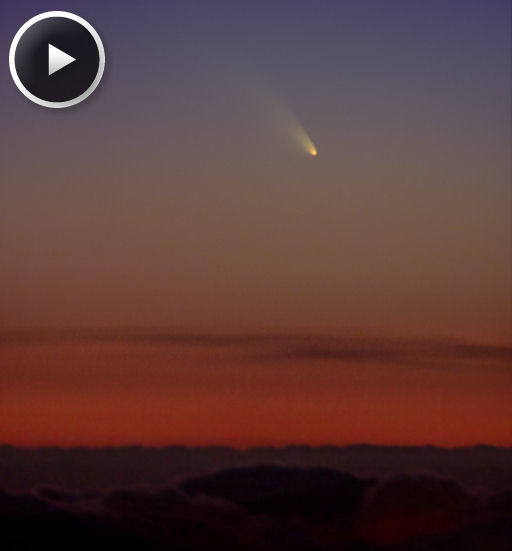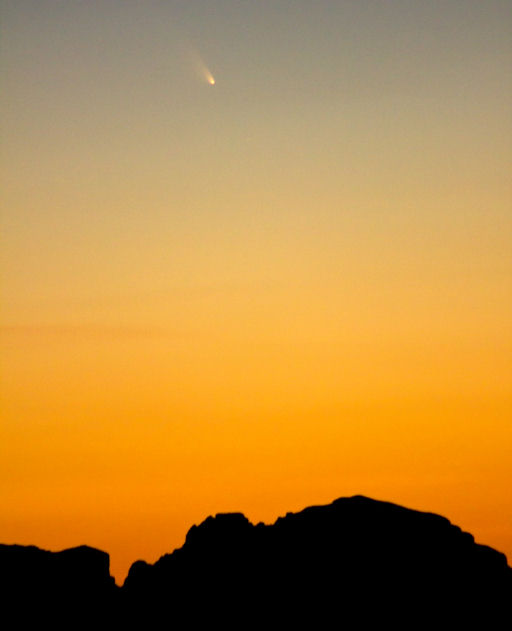Комета Pan-Starrs - странности и несоответствие данных НАСА
12-03-2013, 09:08. Разместил: VP
https://www.youtube.com/embed/e1jxkXjTDKQ]
"Видишь комету Pan-Starrs? Нет. И я не вижу, а НАСА говорит, что она есть...". 10 марта эта комета вошла в зону видимости спутников слежения за Солнцем и казалось бы ожидается очень красивое шоу на снимках со спутников СОХО и СТЕРЕО, но увы - кометы там попросту нет. А НАСА утверждает, что есть и показывает 4 снимка со спутника STEREO-B где якобы именно эта комета и сфотографирована, но кроме этих 4-х снимков ее больше нигде нет.
Вот, что сегодня публикует НАСА и указывает, что на этом снимке мы видим комету Pan-Starrs, но возникает вопрос - если комета видна здесь, то почему ее нет на фотографиях со спутников вообще.
НАСА сообщает, что комета Pan-Starrs 10 марта 2013г приблизилась к Солнцу на максимально близкое расстояние и, что комета пройдет всего в 28 млн км от Солнца, а потом начнет удаляться от светила. Но на снимках СОХО и СТЕРЕО ее вообще нет и это странно, так как с Земли ее по словам астрономов хорошо видно.

Комету по уверениям НАСА, можно будет наблюдать невооруженным глазом с 10 по 13 марта. Pan-Starrs пройдет через созвездия Кита, Рыб, Андромеды и Пегаса.
https://www.youtube.com/embed/bnwIkIa_SXw?rel=0
COMET PAN-STARRS UPDATE: Yesterday, March 10th, Comet Pan-STARRS (C/2011 L4) made its closest approach to the sun. Inside the orbit of Mercury, the comet was hit by solar rays ten times more intense than we experience on Earth. This sets the stage for a good show as Pan-STARRS, glowing brightly, moves into the night sky later this week. Dr. Fritz Helmut Hemmerich of Tenerife (Canary Islands) caught a hint of things to come last night when he photographed the comet setting just behind the sun:
"We went high on the Teide volcano to photograph the comet [above the roiling clouds]," says Hemmerich. "Each frame in the video is a 4 second exposure taken with a Canon 1100D digital camera set at ISO 400."
Although Comet Pan-STARRS is bright, somewhere between 1st and 2nd magnitude, most observers say they are still having trouble seeing it with the unaided eye in the bright evening twilight. A few seconds exposure with a digital camera, however, reveals it easily. Binoculars help, too.
Visibility will improve in the nights ahead as the comet moves away from the sun. Dates of special interest include March 12th and 13th when Pan-STARRS passes not far from the crescent Moon. The tight conjunction on the 12th provides a splendid opportunity for sunset photographers. Look low and west for a beautiful view.
PHOTO-OP TONIGHT: Tonight, March 12th, Comet Pan-STARRS (C/2011 L4) is getting together with the slender crescent Moon for a beautiful sunset conjunction. The only question is, will you be able to see it? Naked-eye observers are having trouble finding the comet in bright twilight. The good news is, it only takes a couple of seconds of exposure time to produce a picture like this:
"This is a 2-second exposure I made using my Canon 2Ti digital camera set at ISO 800," says Russell Vallelunga of Phoenix, Arizona. "Comet Pan-STARRS was even more impressive tonight (March 11th) than last night, being much higher in the sky."
Add the crescent Moon to this scene and presto! -- a fabulous photo-op. Look low and west after sunset for the Moon and Pan-STARRS only a few degrees apart. Let the Moon guide you to the comet; it is visible to the naked eye if you know where to look. Binoculars are helpful, too.
Sky maps:
March 12 http://spaceweather.com/images2013/12mar13/skymap.gif?PHPSESSID=5us035sh1e0iqrvh6n6n978e16
March 13 http://spaceweather.com/images2013/13mar13/skymap.gif?PHPSESSID=5us035sh1e0iqrvh6n6n978e16
http://spaceweather.com/
Вернуться назад

